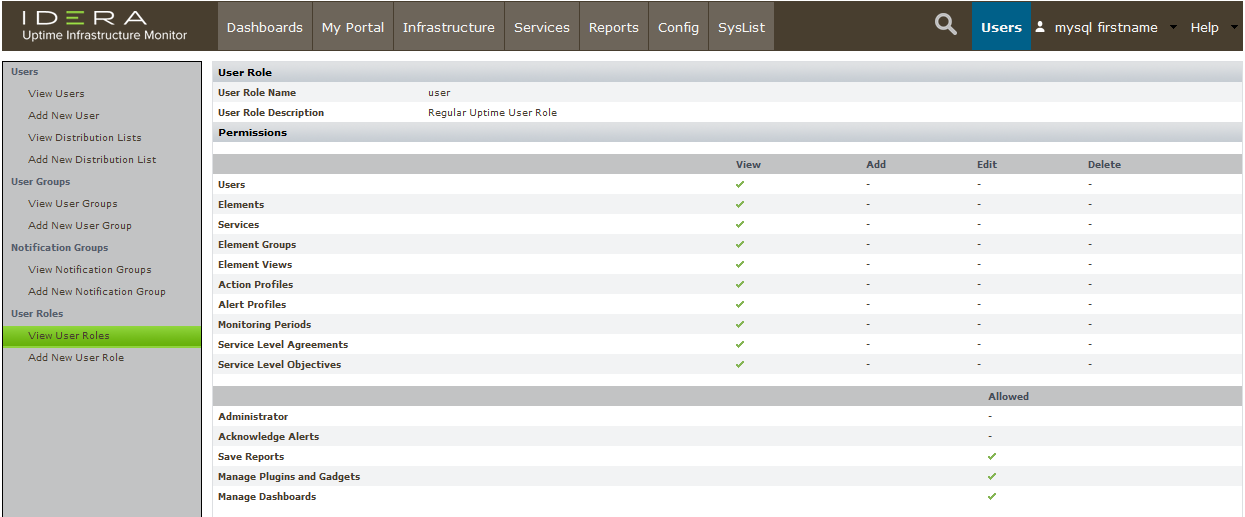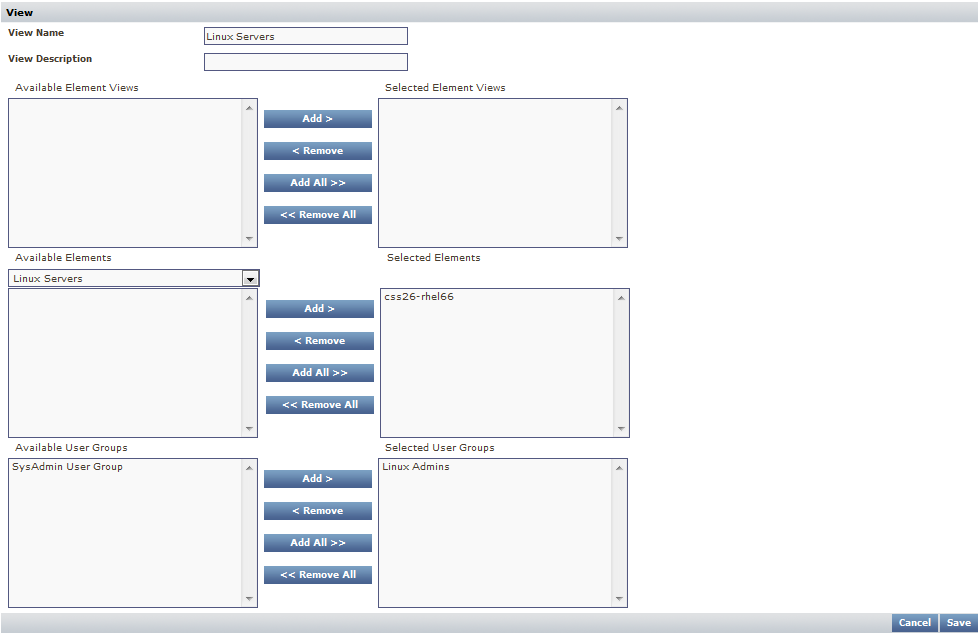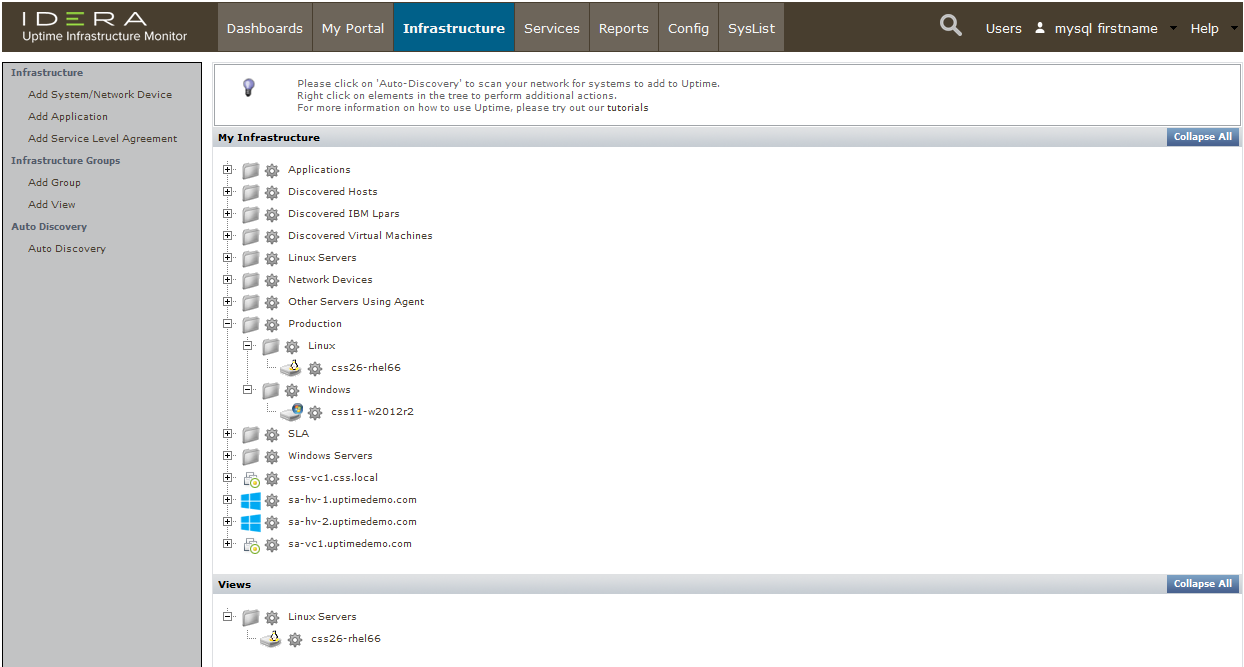...
In this list, you can see that up.time has two default users (admin, or "up.time Administrator" and sample, or "Sample User"). Each one is assigned to its own user role (superadmin, and user), but both belong the same SysAdmin User Group:
To get an idea of which activities in up.time are determined by user role, view the permissions for the user role by clicking its name in the User Role column:
This user role is, for the most part, a "read-only" role, which is appropriate for the non-administrator sample user that is associated with it.
...
- In the left pane, click Add New User Group.
- In the Add User Group pop-up window, provide
Linux Adminsas the User Group Name. Select the sample user from the Available Users list, then click Add.
Select Linux Servers from the Available Element Groups, then click Add.
Your user group configuration should look similar to the following:
Note title A web of relationships Due to an object-based approach, you can associate Elements, Element Groups, and Views with user groups, and vice versa. Later in this module, we will create a View, and associate it with the user group we are creating now. If we had created that View first, we would be able to make that association now.
Also note the Elements and Element Groups in the user group definition determine which Elements members of the group have "access" to. This is one way that user groups imply domain of use. This property works in conjunction with user roles: a user group determines what a user has access to, while the user role determines what they can do with the things they can access.
Click Save, then click Close Window. In the main UI window, the Users panel is displayed.
Validation: The user group you have just created includes the sample user. Conversely, from the user profile (and UI) perspective, the sample user is now a member of the newly created user group. Also note the double group membership for this user; this is a basic example of user-related objects.
Edit an Existing User's Profile
...
- Click the edit icon beside the sample user:
- In the Edit User pop-up window, edit the user's group membership. Select the SysAdmin User Group entry, then click Remove.
- Click Save, then click Close Window.
You are returned to the main UI window, where the User page is in view.
...
- Click My Infrastructure.
- In the left pane, click Add View.
- Configure your View as follows:
- Provide
Linux Serversas the View Name. - Select the Linux Servers Element Group from the Available Elements list, displaying the Linux server Element you added in the previous module.
- Select the Element and click Add.
- From the list of Available User Groups, select and Add the Linux Admins group.
- Provide
- Click Save, then click Close Window.
Validation Step (My Infrastructure): In the main UI window, the My Infrastructure view updates with your newly created Web Servers view. Expand it to see that its contents match what you added from the Web Servers Element Group.
| Note | ||
|---|---|---|
| ||
Even though this created View is strictly for users that are members of the Linux Admins user group, and you are currently logged in as an administrator that is not a member, the View is still visible. An up.time administrator, who has the superadmin user role, will still be able to view everything. |
...
- Click the logged-in admin user name (found along the top tool bar), then click Logout.
- At the log-in screen, log in as the default sample user.
This sample user has an ID and password ofsampleandsample. - Once logged in as the sample user, click My Infrastructure.
Consider the following:
- You can see the View intended solely for the sample user.
- This sample user sees this View because you configured it to be associated with the user group that the user belongs to.
- The user can also see only the same Elements under My Infrastructure because, in the second exercise in this module, you configured the user group to include the Linux Servers Element Groups.
- As explored in the first exercise, this user's role limits activity to view-only tasks. To illustrate, if you click the gear beside an Element, you will not see an Edit option in the pop-up menu.
- The user cannot see anything else on the My Infrastructure panel, since they are administrative actions.
Using Views in conjunction with user roles and user groups can accommodate a diverse set of end users that have access to view, add, edit, or delete the correct Elements or up.time objects.
...







